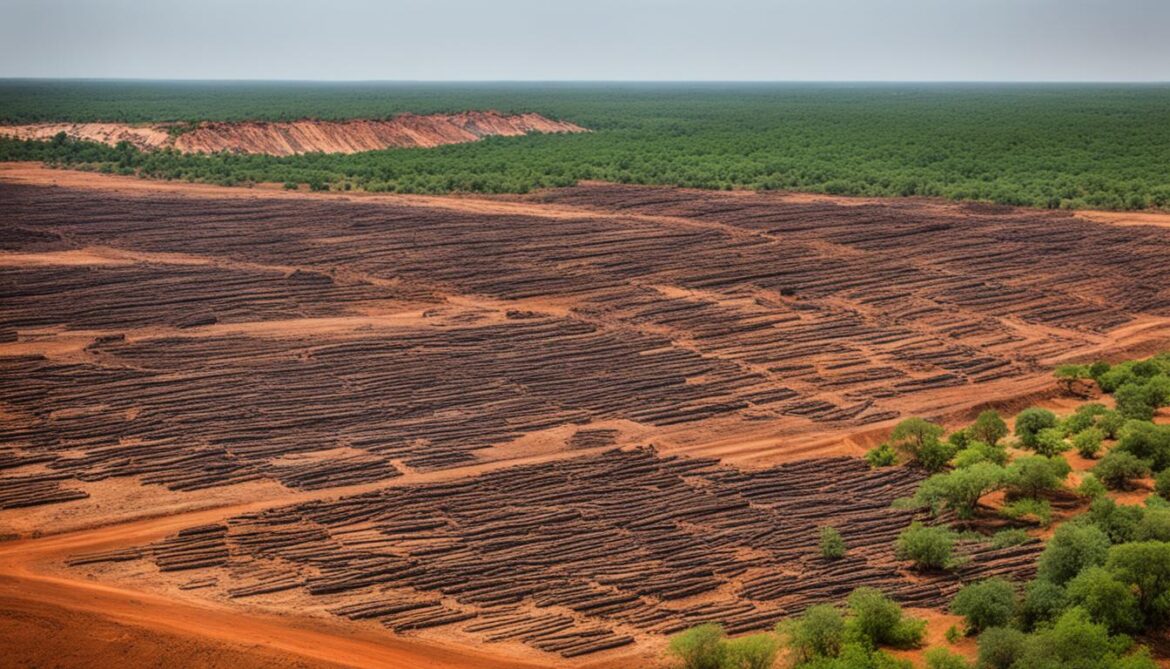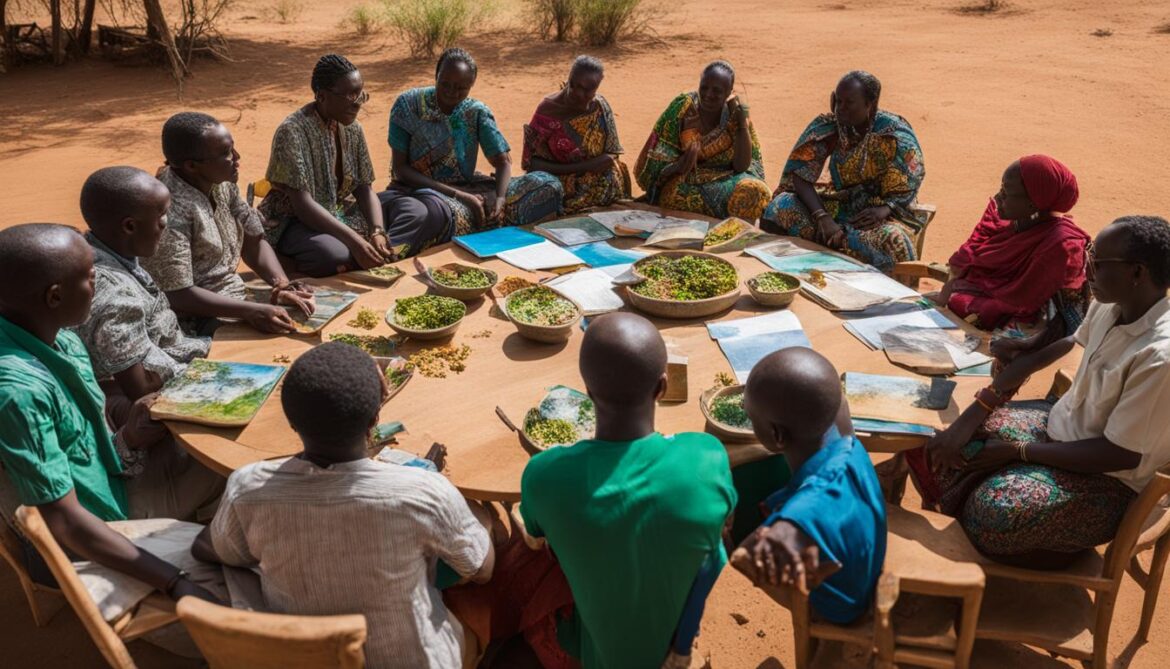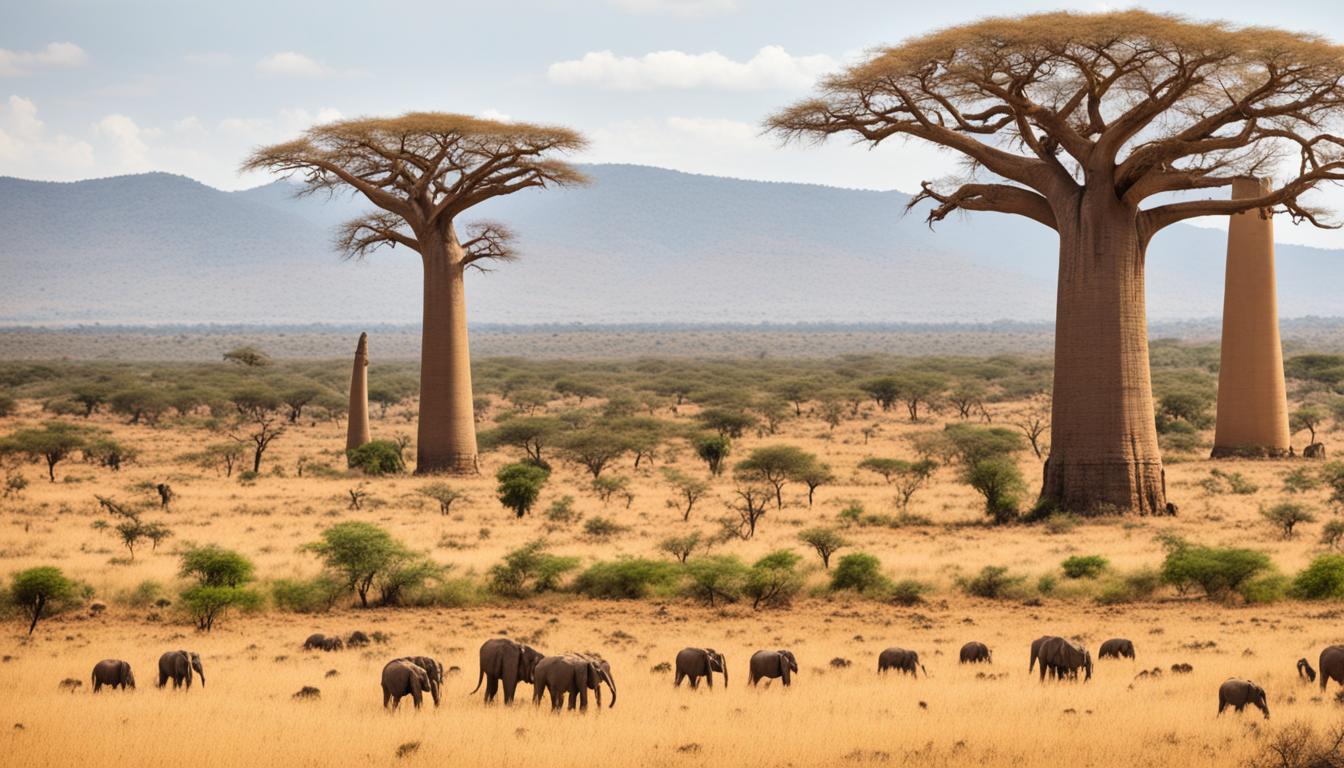Burkina Faso, located in West Africa, is renowned for its remarkable biodiversity and diverse ecosystems. From lush forests to pristine wetlands and majestic mountains, the country’s natural landscapes are home to a wide range of plant and animal species.
However, this biodiversity faces significant threats from deforestation, habitat loss, and human activities such as mining and agriculture. To combat these challenges, Burkina Faso has implemented measures and legislation to protect and manage its environment sustainably.
Key Takeaways:
- Burkina Faso boasts rich biodiversity and diverse ecosystems.
- Deforestation, habitat loss, and human activities pose significant threats to the country’s biodiversity.
- Efforts are being made to protect and manage Burkina Faso’s environment sustainably.
- Collaboration between stakeholders is crucial for promoting sustainable development and preserving biodiversity.
- Preserving Burkina Faso’s biodiversity is essential for the long-term well-being of both the environment and its people.
The Ecological Diversity of Burkina Faso
Burkina Faso is a country rich in ecological diversity, boasting a variety of ecosystems that support a wide range of flora and fauna. From lush forests to vital wetlands and majestic mountain areas, Burkina Faso offers a haven for diverse plant and animal species.
The forests of Burkina Faso are teeming with life, hosting numerous plant species and providing a habitat for many animals. These dense woodlands are not only vital for wildlife but also play a crucial role in carbon sequestration and maintaining the overall ecological balance.
Wetlands, such as the famous Mare aux Hippopotames, are vital breeding grounds for birds and serve as essential habitats for amphibians and reptiles. They are critical for maintaining biodiversity and supporting the survival of various species.
In the mountainous regions of Burkina Faso, unique and endemic plant species thrive, contributing to the country’s remarkable flora. These mountain areas provide a refuge for specialized plants that have adapted to the challenging high-altitude environments.
Burkina Faso’s ecological diversity is not only aesthetically captivating but also essential for the overall health of the environment. The interconnectedness of these diverse ecosystems ensures the preservation of biodiversity and ecosystem services that are vital for the well-being of both wildlife and humans.
The Magnificent Wildlife of Burkina Faso
Burkina Faso is home to a wide array of wildlife, showcasing the harmonious coexistence of flora and fauna. Its diverse ecosystems provide habitats for numerous incredible creatures.
With 128 mammal species, 516 bird species, and 60 reptile and amphibian species, Burkina Faso’s wildlife is truly magnificent. From majestic panthers to graceful birds, these creatures contribute to the country’s rich biodiversity.
“The wildlife in Burkina Faso is a testament to the beauty and diversity of nature. It’s awe-inspiring to witness the coexistence of different species in their natural habitats,” says wildlife conservationist Dr. Sophie Evans.

The Mammal Species of Burkina Faso
Burkina Faso is home to a diverse range of mammal species. Among them are the African elephant, the African buffalo, the hippopotamus, the western giant eland, and the panther. These magnificent creatures play crucial roles in maintaining a balanced ecosystem.
The Bird Species of Burkina Faso
The avian population of Burkina Faso is equally impressive, with 516 recorded bird species. Among them are the grey parrot, the African fish eagle, the marabou stork, the African grey hornbill, and the violet turaco. The country’s forests and wetlands provide essential habitats for these stunning winged creatures.
The Reptile Species of Burkina Faso
Burkina Faso is also home to a variety of reptiles, including 60 species of snakes, lizards, and turtles. The diverse landscapes of the country support the survival of these fascinating creatures, such as the African rock python, the Nile crocodile, the West African crocodile, and the Red-headed agama.
Despite the natural beauty and importance of Burkina Faso’s wildlife, human activities, such as deforestation and habitat loss, pose significant threats to these magnificent species. It is imperative that we prioritize conservation efforts to protect and preserve the incredible wildlife that graces this West African nation.
The Flora of Burkina Faso
Burkina Faso is blessed with a diverse and abundant flora, comprising 1,951 plant species that play vital roles in the country’s ecosystems. Among the notable flora is the shea tree, known for its valuable nuts that are used to produce shea butter. The shea tree (Vitellaria paradoxa), a native species to Burkina Faso, is of great economic and cultural importance to the region. The nuts of the shea tree serve as a source of income for many rural communities, and shea butter is widely used in cosmetics and traditional medicine.
“The shea tree is a symbol of sustainability and empowerment in Burkina Faso. Its nuts provide livelihoods for women who produce shea butter, which has a wide range of applications,” says Fatoumata Sawadogo, a local entrepreneur.
Medicinal plants also form a significant part of Burkina Faso’s flora. The neem tree (Azadirachta indica) and the baobab tree (Adansonia digitata) are two prominent examples. The neem tree, with its potent antimicrobial and anti-inflammatory properties, has been used in traditional medicine for centuries. Additionally, the versatile baobab tree, known as the “Tree of Life,” provides various medicinal and nutritional benefits.
Unfortunately, Burkina Faso’s flora is under threat due to deforestation and unsustainable agricultural practices. These activities result in habitat destruction and the loss of biodiversity. To protect the unique flora of Burkina Faso, it is essential to prioritize preservation efforts and promote sustainable practices.

The Shea Tree: A Cultural and Economic Icon
The shea tree holds significant cultural and economic value in Burkina Faso. Its nuts, which contain a high-fat content, are harvested by local communities. The process of extracting and processing shea butter is a traditional skill that has been passed down through generations. The shea butter industry not only provides employment opportunities but also empowers women who play a central role in its production.
| Key Features |
Benefits |
| High-fat content |
Used in the cosmetics industry for its moisturizing properties |
| Emollient |
Effective in soothing and hydrating the skin |
| Antioxidant properties |
Protects the skin from environmental stressors |
| Natural sunscreen |
Provides UV protection for the skin |
The shea tree’s nuts are collected, sun-dried, and crushed to extract the rich shea butter. This valuable product is used in various cosmetic formulations, including lotions, body butters, and lip balms. Shea butter is praised for its moisturizing, nourishing, and protective properties, making it a sought-after ingredient in skincare products around the world.
“Shea butter harvested from the shea tree in Burkina Faso is of exceptional quality, and its production supports sustainable livelihoods for local communities. The demand for shea butter continues to grow due to its numerous benefits and natural origin,” says Emma Green, a skincare expert.
Preserving and sustainably managing Burkina Faso’s flora, including the majestic shea tree, is crucial for biodiversity conservation and sustainable economic development in the region.
Conservation Efforts
Burkina Faso is committed to protecting its biodiversity through various conservation efforts. The country recognizes the importance of preserving its natural heritage and has implemented strategies to safeguard key habitats and promote sustainable practices.
To ensure the long-term preservation of biodiversity, Burkina Faso has established protected areas, including national parks and reserves. These protected areas serve as havens for diverse plant and animal species, providing them with safe and undisturbed habitats.
One notable protected area is the Arly-Singou Complex, which has been recognized as a UNESCO World Heritage Site. This complex is home to a wide range of flora and fauna, and its conservation status helps maintain the delicate balance of ecosystems in Burkina Faso.
In addition to protected areas, the government has also initiated reforestation programs to restore degraded lands. These programs aim to combat deforestation and promote the growth of indigenous plant species, contributing to the overall health of the environment.
The conservation efforts in Burkina Faso go beyond the physical protection of biodiversity. Education and awareness campaigns play a significant role in fostering a deeper understanding of the importance of conservation and encouraging sustainable practices. By integrating biodiversity considerations into various sectors of the economy, Burkina Faso aims to ensure that conservation becomes an integral part of its development strategies.
| Conservation Efforts in Burkina Faso |
Key Highlights |
| Establishment of Protected Areas |
National parks and reserves safeguarding important plant and animal habitats. |
| Arly-Singou Complex |
A UNESCO World Heritage Site, providing a refuge for diverse flora and fauna. |
| Reforestation Programs |
Initiatives to restore degraded lands and promote the growth of indigenous plant species. |
| Education and Awareness |
Campaigns to foster understanding and promote sustainable practices. |
| Integration into Various Sectors |
Incorporating biodiversity considerations into the country’s development strategies. |
Conservation Efforts in Action
“By establishing protected areas and implementing reforestation programs, Burkina Faso is taking significant steps towards conserving its biodiversity. Through education and awareness, the country is shaping a culture of sustainability and promoting the integration of biodiversity in all sectors. These efforts demonstrate Burkina Faso’s commitment to preserving its natural heritage for future generations.”
Threats to Biodiversity in Burkina Faso
Burkina Faso’s biodiversity faces significant threats due to deforestation, habitat loss, and unsustainable agricultural practices. The country experiences an alarming annual deforestation rate of 4%, leading to the loss of vital habitats for numerous species. The mining sector, especially gold extraction, and the cotton sector also pose major challenges to biodiversity through deforestation, pollution, and habitat destruction.
Various legislation and measures have been implemented to address these threats. However, it is crucial for government agencies, mining companies, and cotton producers to collaborate further in order to effectively tackle these issues and safeguard Burkina Faso’s unique flora and fauna.
Deforestation in Burkina Faso
The country is experiencing a concerning level of deforestation, resulting in the loss of critical habitats and disruption to ecosystems. According to the Food and Agriculture Organization (FAO), Burkina Faso’s annual deforestation rate is 4%. This significant environmental challenge directly impacts the livelihoods of numerous species and poses a threat to their survival.
Deforestation is fragmenting habitats and depleting the natural resources that sustain diverse flora and fauna populations.
Species such as panthers, elephants, crocodiles, and pythons heavily depend on intact habitats. The destruction of these habitats due to deforestation disrupts their natural behavior patterns, migration routes, and breeding grounds. Consequently, the loss of biodiversity in Burkina Faso is a direct consequence of deforestation.
Mining and Cotton Sectors
The mining sector, predominantly gold extraction, and the cotton sector also contribute to the threats faced by Burkina Faso’s biodiversity. Both industries have significant environmental impacts, including deforestation, pollution, and habitat loss.
Mining activities involving the use of heavy machinery and the excavation of large areas result in deforestation and habitat destruction. Additionally, the use of toxic chemicals in mining operations poses a risk to water sources and indirectly affects flora and fauna.
The expansion of the cotton sector contributes to habitat degradation, deforestation, and the inappropriate use of agrochemicals, harming Burkina Faso’s biodiversity.
Sustainable practices in both sectors are crucial to mitigate the negative impacts on biodiversity and preserve the natural heritage of Burkina Faso for future generations.
Collaboration for Conservation
While legislation and measures have been put in place, effective conservation efforts require collaboration among government agencies, mining companies, cotton producers, and other stakeholders. Coordinated actions and shared responsibility are essential to address the threats to biodiversity in Burkina Faso.
By working together, stakeholders can develop and implement sustainable practices that minimize negative environmental impacts. This includes adopting responsible land-use practices, implementing conservation strategies, and protecting important habitats.
| Threats |
Impact on Biodiversity |
| Deforestation |
Loss of critical habitats, disruption of ecosystems, and negative effects on flora and fauna populations. |
| Mining and cotton sectors |
Deforestation, pollution, and habitat loss leading to significant biodiversity degradation and species endangerment. |
Addressing these threats requires a collective effort, with each stakeholder playing a role in promoting sustainable development practices and biodiversity conservation in Burkina Faso. Through collaborative initiatives, the country can preserve its rich natural heritage while ensuring the well-being of its people.

Deforestation and its Impact on Biodiversity
Deforestation in Burkina Faso is occurring at an alarming rate, leading to the loss of critical habitats for numerous species. The country’s annual deforestation rate is 4%, according to the Food and Agriculture Organization (FAO). The direct impacts of deforestation include the fragmentation of habitats and the loss of natural resources. This poses threats to species such as panthers, elephants, crocodiles, and pythons. Addressing deforestation and its impact on biodiversity is crucial for the preservation of Burkina Faso’s natural heritage.
A recent study conducted by the Burkina Faso Biodiversity Research Center revealed the devastating effects of deforestation on local wildlife populations. The loss of forest cover has led to decreased food sources and disrupted migration patterns for many species. Panthers, once abundant in the country, have seen their numbers dwindle due to deforestation, pushing them closer to extinction. Elephants, crocodiles, and pythons also face heightened risks as their habitats become fragmented and their access to resources diminishes.

The consequences of deforestation extend beyond individual species. As habitats are destroyed and natural resources depleted, the delicate balance of Burkina Faso’s ecosystems is disrupted. This has broader implications for the overall health and ecological stability of the region. Loss of biodiversity can lead to decreased resilience to environmental changes, reduced ecosystem services, and potential cascading effects throughout the food web.
To combat deforestation and its impact on biodiversity, collaborative efforts are necessary. The Burkina Faso government, in partnership with international organizations and local communities, has implemented various initiatives to address this issue. These initiatives focus on sustainable land management, reforestation, and raising awareness about the importance of preserving biodiversity.
“We cannot ignore the consequences of deforestation on our natural heritage. It is a responsibility we all share to protect and restore the ecosystems that support life,” said Dr. Aminata Sankara, Director of the Burkina Faso Biodiversity Research Center.
Efforts are underway to create protected areas, establish sustainable land-use practices, and promote responsible forestry practices. The government is also investing in education and capacity-building programs to empower local communities to actively participate in conservation efforts.
Threatened Species in Burkina Faso
| Species |
Status |
Primary Threat |
| Panthera pardus |
Endangered |
Deforestation |
| Loxodonta africana |
Vulnerable |
Habitat Loss |
| Crocodylus niloticus |
Endangered |
Fragmentation of Habitats |
| Python regius |
Threatened |
Loss of Natural Resources |
It is essential to recognize that the impact of deforestation on biodiversity is not limited to Burkina Faso alone. Deforestation has far-reaching consequences for the global ecosystem and contributes to climate change. By addressing deforestation in Burkina Faso and implementing sustainable practices, we can contribute to the preservation of the world’s biodiversity and ensure a sustainable future for generations to come.
Nationwide mobilization
Burkina Faso recognizes the urgent need to address the degradation of biodiversity in the country. To combat this issue, the Burkina Faso Multi-Stakeholder Working Group for the Integration of Biodiversity into Economic Development (GTMIBE) has been established. The GTMIBE aims to promote constructive dialogue, information sharing, and collaboration among various stakeholders to reverse the alarming trends of biodiversity loss.
Threats to soils and biodiversity in Burkina Faso are multifaceted and require concerted efforts. Deforestation, habitat fragmentation, overgrazing, and pollution from mining and agricultural activities pose significant challenges to the preservation of biodiversity. These threats not only impact the natural ecosystems but also have far-reaching consequences on the socio-economic well-being of the country.
The GTMIBE has developed a comprehensive three-year action plan to address these issues. The plan focuses on capacity building, knowledge dissemination, and multisectoral cooperation as essential pillars for effective biodiversity conservation. By enhancing the understanding of the value of biodiversity in economic development, the GTMIBE aims to encourage sustainable practices that promote both environmental protection and economic growth.
In collaboration with government agencies, NGOs, private sector organizations, and local communities, the GTMIBE strives to create a coordinated and harmonious approach to biodiversity conservation. By fostering partnerships and promoting inclusive decision-making processes, the working group seeks to ensure the long-term preservation of Burkina Faso’s unique biodiversity.
Highlights of the GTMIBE three-year action plan:
- Capacity building programs to enhance knowledge and skills in biodiversity conservation
- Establishment of biodiversity-friendly agricultural practices
- Promotion of sustainable forestry management and reforestation initiatives
- Integration of biodiversity considerations into economic development strategies
- Enhancement of monitoring and enforcement mechanisms for environmental regulations
Through the GTMIBE’s collaborative efforts, Burkina Faso aims to mobilize a nationwide response to the threats facing its soils and biodiversity. By recognizing the importance of biodiversity in economic development, the country can pave the way for a sustainable future, where nature and human prosperity coexist harmoniously.
| Threats to Soils and Biodiversity |
Solutions and Actions |
| Deforestation |
Reforestation programs and sustainable forestry management |
| Habitat Fragmentation |
Protected area establishment and habitat restoration initiatives |
| Overgrazing |
Implementation of sustainable land management practices |
| Pollution from Mining and Agricultural Activities |
Enforcement of environmental regulations and adoption of eco-friendly practices |

Dialogue: stakeholders
Addressing the threats to biodiversity in Burkina Faso requires the collaborative efforts of various stakeholders. The Gold Industry, being a significant contributor to the country’s economy, has taken proactive measures to support the management of protected areas and improve mining practices. This commitment is aimed at minimizing the negative impact of mining activities on the environment and preserving the unique flora and fauna found in these regions.
The Cotton Sector, as a major cash crop in Burkina Faso, acknowledges its role in biodiversity conservation. It is actively working towards promoting sustainable farming practices and supporting the use of organic inputs. By reducing the use of harmful chemicals and implementing eco-friendly techniques, the Cotton Sector aims to mitigate the negative effects on the environment and preserve the delicate balance of biodiversity.
In addition to industry stakeholders, institutional actors such as mining companies, cotton producers, and civil society organizations are actively involved in the preservation of biodiversity. They play crucial roles in monitoring compliance with environmental regulations, raising awareness about the importance of conservation, and implementing sustainable practices.
Collaborative Actions
The stakeholders in the Gold Industry and the Cotton Sector are committed to biodiversity conservation by implementing various actions:
- Collaborating with local communities and environmental organizations to develop sustainable practices
- Investing in research and development to identify innovative solutions for minimizing the negative environmental impact
- Supporting initiatives that promote reforestation and habitat restoration
- Developing monitoring systems to ensure compliance with environmental regulations
- Conducting regular environmental impact assessments to identify and address potential threats
Through these collaborative efforts, stakeholders are working towards a shared vision of protecting Burkina Faso’s biodiversity and promoting sustainable development.
“The conservation of biodiversity requires a collective effort from all stakeholders. By integrating sustainable practices into our industries and supporting local communities, we can ensure the preservation of Burkina Faso’s natural heritage for future generations.” – Representative from the Gold Industry

| Stakeholder |
Actions |
| Gold Industry |
Supporting the management of protected areas |
|
Improving mining practices for reduced environmental impact |
| Cotton Sector |
Promoting sustainable farming practices |
|
Supporting organic inputs |
| Institutional Stakeholders |
Monitoring compliance and raising awareness |
Conclusion
Preserving biodiversity in Burkina Faso is essential to maintain the delicate balance of ecosystems and safeguard the country’s natural heritage. Through coordinated efforts and the implementation of sustainable practices, Burkina Faso can prioritize the protection of its unique flora and fauna for the benefit of future generations. Continued collaboration between stakeholders, along with legislation, capacity-building, and funding support, is crucial for the long-term preservation of Burkina Faso’s biodiversity and the promotion of sustainable development.
By adopting sustainable practices such as reforestation and responsible mining techniques, Burkina Faso can mitigate the threats posed to its biodiversity. It is imperative for the government, industry, and civil society to work hand in hand to address deforestation, habitat loss, and pollution caused by human activities. Additionally, raising awareness and educating the public about the value and importance of biodiversity preservation will strengthen the commitment towards a sustainable future.
In conclusion, Burkina Faso holds a wealth of natural treasures that must be protected and cherished. By conserving its biodiversity, Burkina Faso can achieve a harmonious coexistence between humans and nature, ensuring a sustainable and prosperous future for both. Together, let us embrace the responsibility of preserving Burkina Faso’s unique ecosystems and pave the way towards a more environmentally conscious society.
FAQ
What is the importance of biodiversity in Burkina Faso?
Biodiversity in Burkina Faso is crucial for maintaining healthy ecosystems, contributing to the country’s natural heritage, and supporting the livelihoods of local communities.
What are the main threats to Burkina Faso’s biodiversity?
Deforestation, habitat loss, mining activities, and unsustainable agricultural practices pose significant threats to the biodiversity of Burkina Faso.
What conservation efforts are being implemented in Burkina Faso?
Burkina Faso has established protected areas, such as national parks, and implemented reforestation programs to conserve biodiversity. Awareness campaigns and integration of biodiversity considerations into various sectors are also taking place.
How does deforestation impact biodiversity in Burkina Faso?
Deforestation leads to the loss of critical habitats for many species, fragmentation of ecosystems, and depletion of natural resources, posing significant threats to the flora and fauna of Burkina Faso.
What is the Multi-Stakeholder Working Group for the Integration of Biodiversity into Economic Development (GTMIBE)?
GTMIBE is a working group in Burkina Faso that aims to promote dialogue, collaboration, and information sharing among stakeholders to address biodiversity degradation and sustainable economic development.
How are stakeholders involved in biodiversity conservation in Burkina Faso?
Stakeholders, including the Gold Industry, Cotton Sector, institutional organizations, mining companies, and civil society organizations, actively participate in monitoring, compliance, and awareness-raising efforts to promote sustainable practices and support biodiversity conservation in Burkina Faso.
Why is it important to preserve biodiversity in Burkina Faso?
Preserving biodiversity in Burkina Faso is vital for maintaining the balance of ecosystems, protecting the country’s natural heritage, and ensuring sustainable development for future generations.
Source Links
























Post comments (0)